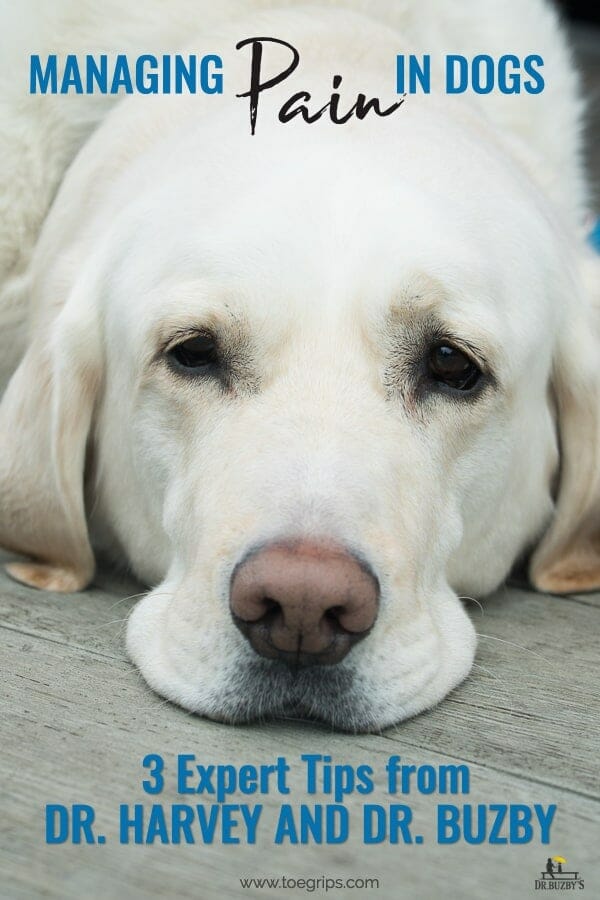
Pain in Dogs: An Expert Interview
Dr. Ralph Harvey and Dr. Julie Buzby discuss chronic pain and pain management in dogs
If your canine companion has ever experienced pain, you understand how important it is to manage both the physical discomfort and emotional stress associated with it. I had the great pleasure of interviewing Dr. Ralph Harvey about chronic pain in dogs while attending a veterinary conference where he was a guest lecturer on this subject.
I’m blessed to introduce to you Dr. Harvey, who teaches anesthesia and pain management in the Department of Small Animal Clinical Sciences at the University of Tennessee College of Veterinary Medicine. With 33 years of experience, Dr. Harvey offers a wealth of wisdom and knowledge about managing pain in dogs. He is an expert authority for anyone who wants to learn more about the stress, fear, and anxiety associated with a painful dog.
Through my conversation with Dr. Harvey, I hope to pass along to you important tips on understanding chronic pain in dogs, how to recognize when a dog is suffering, and insights on the emotional component of pain.

1. Chronic pain in dogs differs from pain in humans
Dr. Julie Buzby: Could you please share your thoughts on how chronic pain in dogs is defined and explain how it differs from pain in people?
Dr. Ralph Harvey: Thank you, Dr. Buzby. You and I share a lot of similar viewpoints along with a passion for taking care of our dear old patients. It’s an honor to be interviewed for your podcast and blog.
As you mention, chronic pain in dogs is often defined a little differently than it is in human medicine. In humans, chronic pain often encompasses things like neuropathic pain–a pain that exists in the absence of real tissue pathology. It may be phantom limb pain. It may be residual back pain that plagues a patient for years after what may have been a minor injury. But the residual pain is in excess of the underlying tissue pathology.
When we talk about chronic pain in dogs, we more often talk about chronic diseases that are concurrent with the pain. For example, the pain of osteoarthritis, the pain of degenerative joint disease, and the pain of cancer. We look for sources of the pain. Sometimes it’s something that we can definitively treat. In other cases, it’s a lifetime illness. With osteoarthritis, for instance, pain management is an integral part of managing that disease. Our therapeutic modalities are often related to the disease process.
Using the example of osteoarthritis, one of the mainstays of therapy is nonsteroidal anti-inflammatory agents. Additionally, our goal is to get the patient moving. We want to keep the dog trim so that he or she can get exercise. Our ability to improve the dog’s mobility is key to keeping them functioning. There’s an old saying with regard to old age and degenerative joint disease:
Rest is rust and motion is lotion.”
As long as dogs can move, they will move. Once they can no longer comfortably move, they become inactive. That leads to more and more disuse.
Dr. Buzby: I love that saying. I have a passion for maintaining mobility in dogs. One of my products, ToeGrips® dog nail grips, helps senior dogs that struggle with slipping on smooth surfaces like hardwood floors. It’s so critical to get these dogs re-engaged with their families. If they’re afraid of walking on the floors in their home, if they’ve isolated themselves to a throw rug or a bed, they’re no longer engaged. The emotional aspect is critical.
2. Pain in dogs is both an emotional and sensory experience
Dr. Buzby: In veterinary medicine, so much attention has been given to quantifiable metrics and measurements and biomarkers, but you talked about the emotional impact of pain. Specifically, could you speak to the continuum of fear, stress, and anxiety in relation to how a dog perceives pain? What is the emotional impact of pain in dogs?
Dr. Harvey: Thanks for bringing that up. While the emotional aspect of pain in dogs is not a new topic, it is one that is so important and it has not received the attention that it deserves. Pain is both an emotional and a sensory experience associated with tissue pathology or the potential for tissue pathology. It includes the emotional as well as the sensory components. It is easier to measure the sensory components and more difficult to quantify the emotional components.
The IASP, International Association for Study of Pain, defines pain in dogs as 'both an emotional and sensory experience associated with tissue pathology or the potential for tissue pathology.'Click To Tweet
Both components are included, but the emotional aspect is difficult to quantify.
Dr. Franklin McMillan, a veterinary specialist, has been speaking about the emotional component of pain for a long time. He asserts that the emotional aspect of pain is the most important component that veterinarians treat in animals. We need to get dogs engaged in life. Chronic pain interferes with that. One of the quotes from his discussions is by Sigmund Freud:
The man with a toothache cannot be in love.”
In other words, chronic pain in dogs interferes with the human-animal bond. We need to alleviate the animal’s emotional component–the suffering component– of pain. When we do that, then dogs are more motivated to engage in life, engage in the human-animal bond, and move around.
Veterinarians are working toward strategies to clearly evaluate the emotional component of pain. One of the aspects that I hope to weigh in on in the future, with full respect and admiration for those who evaluate the somatic component of pain, is the continuum of fear, anxiety, stress, and pain. Some aspects are easier to measure. Some are more difficult. It’s challenging to quantify the emotional component to suffering, and yet we know that it is so important.
3. Recognize the signs that your dog is in pain and share this information with your vet
Dr. Buzby: Yes, I think it’s often the dog owner who is attuned to and intuitively knows how their dog is feeling. Can you help dog owners know what to look for as signs of pain in dogs?
Dr. Harvey: Dog owners can look for changes in their dog’s normal behavior. Often dog owners will pick up on variations in appetite, mood, or response to being petted. Some dogs will become inappropriately aggressive or stressed. Other dogs show signs of pain by being slow to rise, reluctant to go for walks, or by tiring more readily. The dog owner who shares this information with his or her vet can really help. Here are some questions a dog owner can answer to evaluate whether his or her dog is in pain:
- Has your dog’s food consumption decreased?
- Has your dog lost interest in play behaviors? Is your dog less interested in playing with other dogs? Even old dogs will continue to play if they’re comfortable.
- Is your dog willing to go on walks?
- Does your dog tire readily?
- What is your dog’s exercise tolerance?
- Has your dog become reluctant to go outdoors because he has to walk down a landing or walk downstairs?
Dr. Buzby: Thank you, Dr. Harvey. I encourage dog owners to watch for these signs and disregard them as “my dog is just getting old.” There is so much that can be done. Diagnostics are the first step. There are many treatment options–from Western traditional medications to complementary therapies like acupuncture, chiropractic, and rehabilitation medicine. There may be a solution that can help your dog live a happier, healthier, longer life. Be proactive about having these conversations with your vet.
Final thoughts: Treating pain in dogs through multi-management has a synergistic effect
Dr. Buzby: Certainly, no discussion of understanding pain in dogs would be complete without mentioning the synergistic effects of multi-management. In other words, one plus one can equal three. By combining certain drugs, supplements, or modalities, the whole is greater than the sum of the parts. For example, a dog who is taking a Western medication for pain may also take a joint supplement and acupuncture or a cold-laser treatment.
For dogs with chronic pain (like osteoarthritis, neurologic pain, or any ongoing pain), it is crucial to speak with your veterinarian about implementing a multi-management approach. If your vet doesn’t offer solutions such as acupuncture, cold-laser therapy, class four or class three therapeutic laser options, you can ask for a referral.
Dr. Buzby: I can’t thank you enough for joining us, Dr. Harvey. I’m so honored that you’ve taken the time to share your wisdom so that dog owners can make informed decisions on how to help manage chronic pain in dogs.
Do you have questions about managing pain in dogs? Please comment below.
For even more information, please listen to my entire podcast: Managing Pain in Dogs with Dr. Ralph Harvey You can find all of my latest podcasts on The Buzby Dog podcast page.



Hello there, I have an 8 year old buddy whos shivering 3 months now, we done every blood test we could possibly do, everything that our vet said, but we didnt make a conclusion..
at a first glance vet said it was pancreatitis,it wanst,i dont think its cushing syndrome(neither my vet)so i want to ask,is there possible a constant shivering could be from osteoarthritis ?
Thank you for your time,
Regards, Panos
Hi Panos,
I am sorry your pup is dealing with constant shivering. I can only imagine how hard it must be to see him struggling and still have no answers after doing everything you could to find the source of this issue. Without examining your dog, myself, I can’t tell if his shivering is due to pain, but it is possible. Pain can show up in many different ways. Trembling is definitely a possibility. It might be worth discussing this with your vet and see if they are willing to do a trial course of pain medication. I hope you can find the answers you need to ensure your sweet boy is happy and comfortable. Praying for a quick resolution.
my dog got his front left arm amputated an it’s been bout 4_5 months but he gets tired easy an breaths heavily all the time an his owner my brother just pass he is sad can any of them be the reason he is breathing hard or pain pls let me no thanks
Hi Kimberly,
I am so sorry for the recent loss of your brother. My heart goes out to you as you work through your emotions and grief. Heavy breathing or an increased respiratory rate can be symptoms of many different issues in dogs. Since I haven’t examined your pup myself, I can’t make specific conclusions about the cause. I highly recommend you have your dog examined by your vet and let them determine what the next steps should be. Bless you both. ♥
My dog is 15 years old and has had bad breath for a long time. he chatters. my vet has done labs hasn’t found anything medically wrong. I know he is in pain don’t have money to have his teeth done. his teeth are bad he won’t let anyone look at them.. do you have any resources for low income to have this taken care of?
Hi Renae,
I am sorry your senior guy is dealing with dental disease and pain. Unfortunately, I am not aware of any financial support for these types of situations. I recommend you contact your local humane society or any rescues in the area and see if they have any advice. Also, some veterinary clinics have angel funds for owners that try to do what is recommended but are facing financial limitations. If you have not discussed these concerns with your vet, I encourage you to do so. Hoping for a clear path forward and wishing your sweet boy all the best.
Thanks for your helpful info. Most of that I know and am doing. However, my 14 1/2 year old Aussie is on a combination of pain medications, joint therapies, and other helps, including toegrips. But she still is very uncomfortable, whines a lot, and often can’t settle down.
How do we determine when the most loving response might be to put her down? We love her dearly, but we are struggling with if/when to make that choice. Do you have any guidelines? Thanks so much!
Dear Mary Lou, Thank you for your comment. I take all our reader’s comments very seriously, but I have to confess that yours really touched my heart. I understand what you are asking and just walked through the painful “when it is time?” discussions with one of my dearest friends and her 15-year-old dachshund. The guidelines I go by are not scientific. I ask myself the question: “What defines quality of life for this dog and how can I measure that?” The whole process is very subjective, yet I know you are more in tune with your dog than anyone else and I think you’re used to dealing in the subtleties, even if you don’t realize it. Criteria that are important to me are the dog’s ability to enjoy things that they’ve always enjoyed–getting up and moving around, eating meals, interacting with people, etc. These are different for each dog, but that’s a good place to start. Is your dog still able to do the things you know she loves? Then I’d ask how the dog looks overall–posture, ear carriage, brightness of eye, coat, gait. I’m not talking about this from the perspective of a medical exam, looking at gum color and pulse quality, etc. But I’m looking at it from how would your dog appear to your grandmother or friend. Would she say, “That dog might have a lot of grey hair, but she’s still got the will to live” or “That dog looks like she’s given up?” It may be helpful to have a family member, neighbor, or your veterinarian, who hasn’t seen the dog is a while, help you with this assessment. Also, keep in mind that a senior dog often has good days and bad days. I expect this and don’t panic on the bad days. But when we start to string together the bad days, I worry. Of course you’ll certainly want to get your veterinarian involved too. An objective complete physical exam (plus any recommended diagnostic tests) will yield information that your dog can’t voice and you can’t perceive. That information will be an integral part of the decision making process. But I want to end with one piece of hope. In your comment, you described your dog’s whining and inability to settle down. Especially if this is happening in the evening/at night, what you are perceiving as discomfort may not be. These are classic signs of canine cognitive disorder (doggie senility), which can often be helped greatly by medication and supplements. Here’s a good article: https://www.petmd.com/dog/conditions/neurological/5-signs-dog-dementia on this subject.
I hope this is helpful and wish you wisdom and peace as you navigate these challenges.